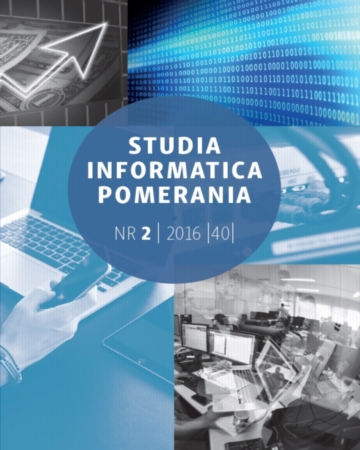
ISSN: 2451-0424
eISSN: 2300-410X
OAI
DOI: 10.18276/si.2016.39-03


Issue archive /
nr 39
Paradygmat programowania proceduralnego w procesie budowy systemów automatycznych bazujących na średnich kroczących
(The procedure programming paradigm as a method of constructing automatic transaction systems based on moving averages)
| Authors: |
Przemysław
Juszczuk
Uniwersytet Śląski w Katowicach, Wydział Informatyki i Nauki o Materiałach Jan Kozak Uniwersytet Ekonomiczny w Katowicach, Wydział Informatyki i Komunikacji |
| Keywords: | procedural programming moving averages transaction system |
| Data publikacji całości: | 2016 |
| Page range: | 11 (25-35) |
Abstract
In this article we propose a novel approach for the generating transaction systems based on the technical analysis indicator – moving averages. Crossover of the moving average with the price chart is considered as a signal. Mechanism of setting the moving average period will be decreased in case of efficient trading. On the other hand, a couple of loss making trades leads to the increasing the moving average period. This will directly affect of decreasing number of trades. Such approach will be compared with the classical solutions based on crossover of two moving averages. Such mechanism will be presented as a system based on the procedural programming paradigm, in which stand-alone block codes are system functions. This will allow to easily expand some system functionalities without increasing code complexity.
Download file
Article file
Bibliography
| 1. | Aldridge, I. (2013). High-Frequency Trading: A Practical Guide to Algorithmic Strategies and Trading Systems. 2 edition. New Jersey, USA: Wiley. |
| 2. | Droke, C. (2001). Moving Averages Simplified. Columbia, USA: Marketplace Books. |
| 3. | FXQuant (2012). Podręcznik użytkownika FXQuant. Pobrane z: http://www.fxpro.co.uk/Doc/FxPro-Quant-User-Manual.pdf (grudzień 2015). |
| 4. | Galan, M., Dolan, B. (2007). Currency Trading for Dummies. New Jersey, USA: John Wiley & Sons. |
| 5. | Jevons, L.C. (1987). Fundamental Analysis and the Stock Market. Journal of Business Finance & Accounting, 14 (1), 131–141, DOI: http://dx.doi.org/10.1111/j.1468-5957.1987.tb00534.x. |
| 6. | Michalik, K. (2006). PC-Shell – Hybrid Expert System Shell, e-book. Katowice: Aitech. |
| 7. | MQL4 (2005). Dokumentacja. Pobrane z: http://docs.mql4.com (grudzień 2015). |
| 8. | Ramasamy, R., Mohd, H.M.H. (2011). Chaotic Behavior of Financial Time Series An Empirical Assessment. International Journal of Business and Social Science, 2 (3), 77–83. |
| 9. | Rhea, R. (1932). Dow Theory. New York: Barron’s. |
| 10. | Rishi, K.N. (2013). Inside the Black Box: A Simple Guide to Quantitative and High Frequency Trading, 2 edition. New Jersey, USA: Wiley. |
| 11. | Russell, R., Wasendorf, Sr. (1997). Foreign Currency Trading: From the Fundamentals to the Fine Points. New York, USA: McGraw-Hill. |
| 12. | Volman, B. (2011). Forex Price Action Scalping: an in-depth look into the field of professional scalping. Indie: Light Tower Publishing. |